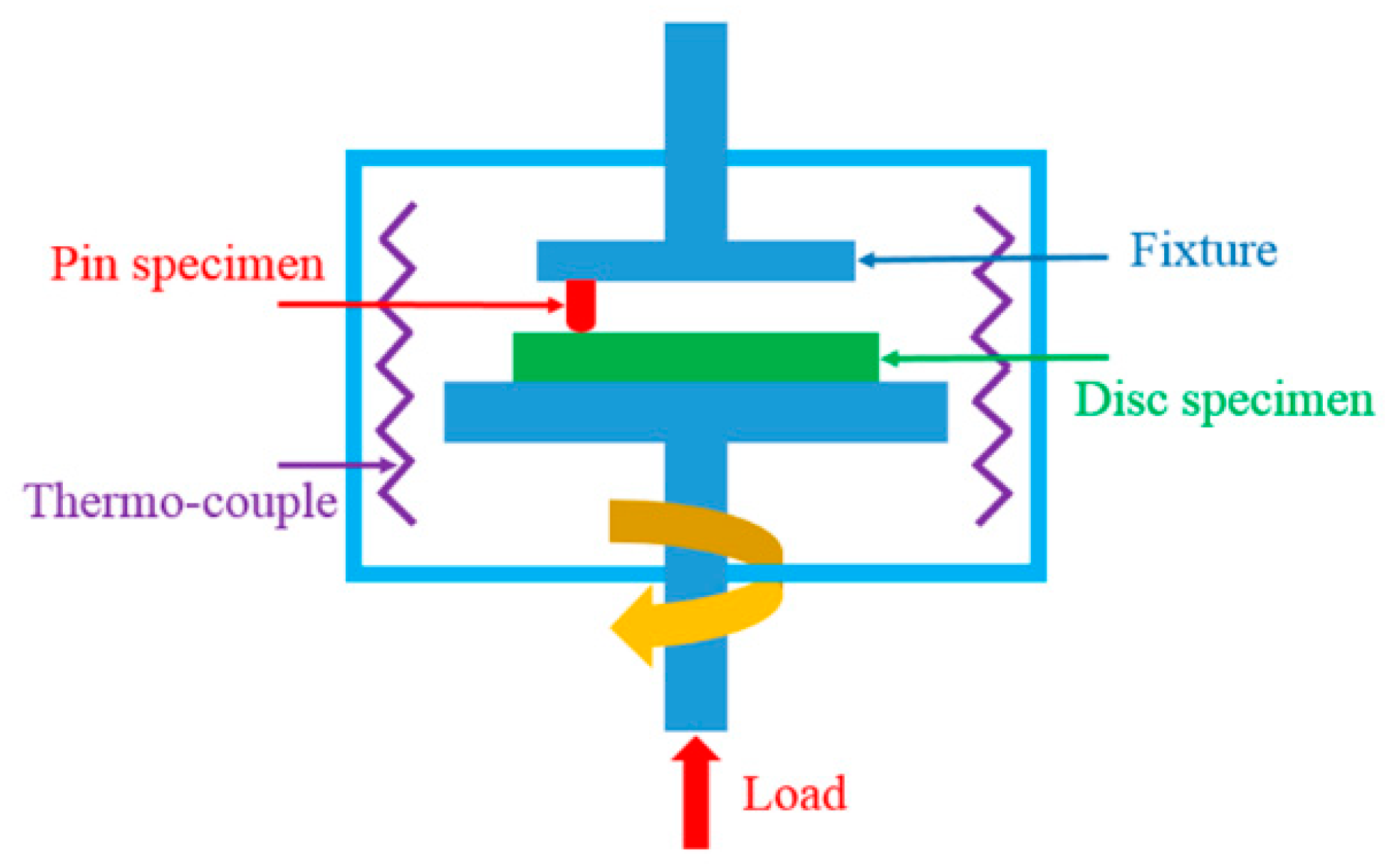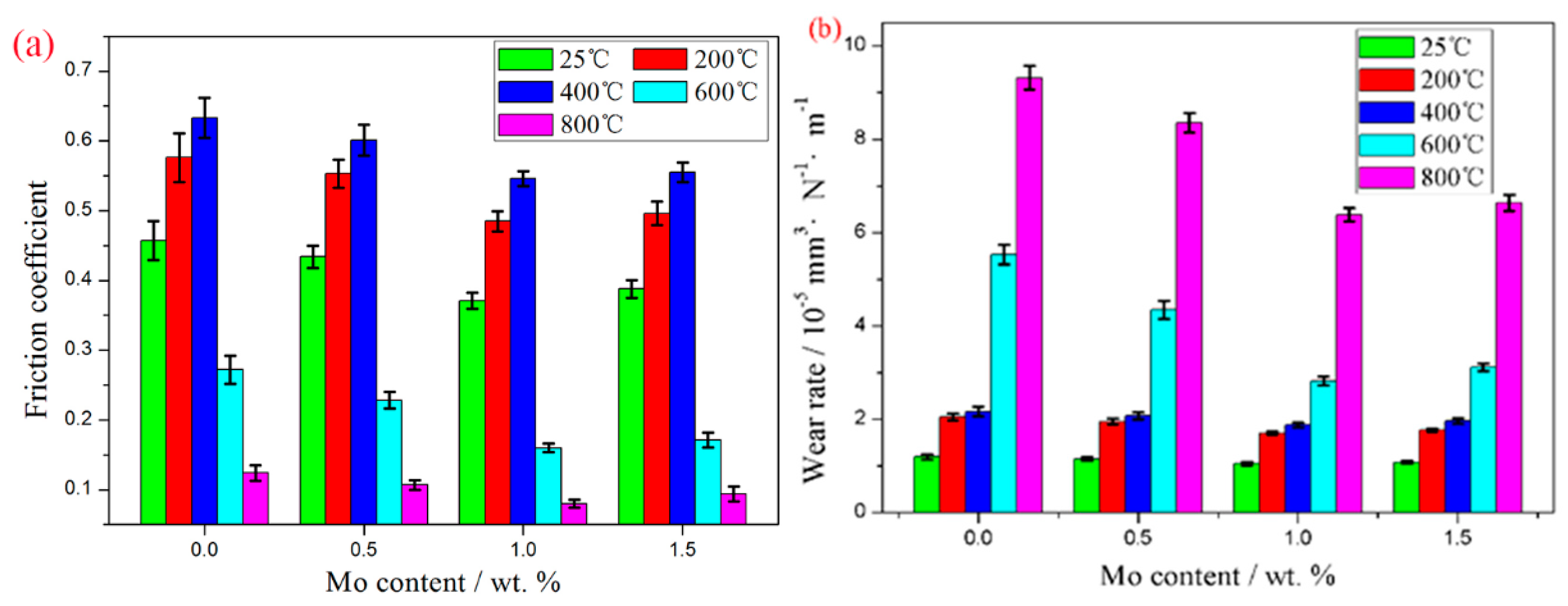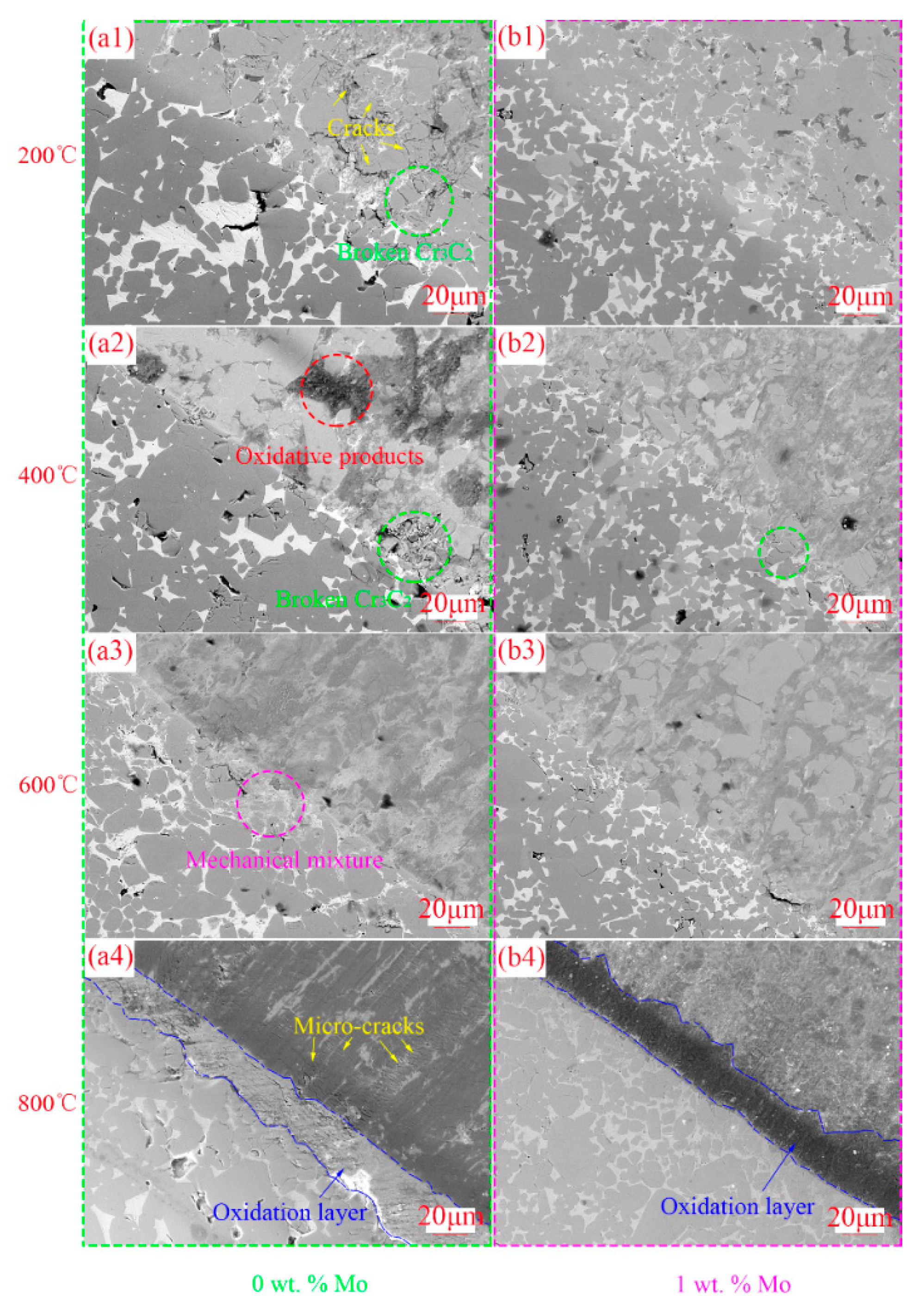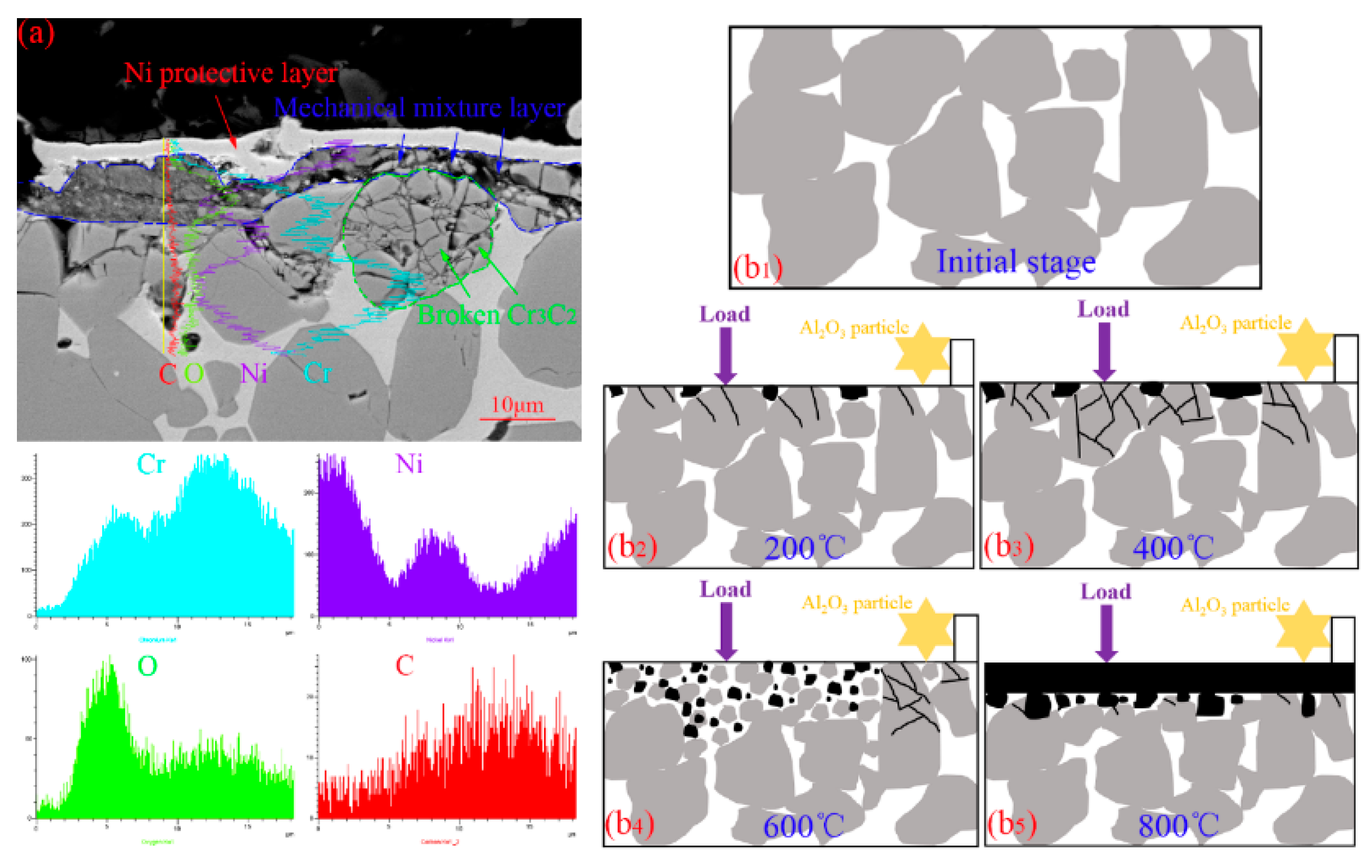Improvement of High Temperature Wear Behavior of In-Situ Cr3C2-20 wt. % Ni Cermet by Adding Mo
Abstract
:1. Introduction
2. Experimental Method
2.1. Preparation of In-Situ Cr3C2-20 wt. % Ni Cermet
2.2. Wear Resistance Test of In-Situ Cr3C2-20 wt. % Ni Cermet
2.3. Materials Characterization
3. Results and Discussion
4. Conclusions
- (1).
- The wear rates are 2.17 and 1.88 × 10−5 mm3·N−1·m−1 at 400 °C, 9.32 and 6.38 × 10−5 mm3·N−1·m−1 at 800 °C for the specimens without Mo and with 1.0 wt. % Mo addition. It can be concluded that the wear resistance of Cr3C2-20 wt. % Ni cermet is enhanced for 13.4% (at 400 °C) and 31.5% (at 800 °C) by 1 wt. % Mo additive.
- (2).
- The wear mechanism of the cermet is abrasive wear at 200–400 °C and changes to severe oxidation and adhesive wear at 600–800 °C.
- (3).
- The wear resistance of Cr3C2-20 wt. % Ni cermet is improved distinctly by adding 1 wt. % Mo, which attributes to the superior hardness of the newly formed (Cr, Mo)7C3 ceramic particle and the lubrication phase of MoO3.
Author Contributions
Funding
Conflicts of Interest
References
- Chen, Z.; Qin, M.; Chen, P.; Huang, M.; Li, R.; Zhao, S.; Qu, X. WC-Co-Cr3C2-VC nanocomposite powders fabricated by solution combustion synthesis and carbothermal reduction. Ceram. Int. 2017, 43, 9568–9572. [Google Scholar] [CrossRef]
- Zhai, W.; Gao, Y.; Sun, L.; Wang, Y.; Niwa, K.; Hasegawa, M. High pressure in-situ synthesis and physical properties of Cr3C2-Ni cermets. Ceram. Int. 2017, 43, 17202–17205. [Google Scholar] [CrossRef]
- Fu, C.; Wu, J.; Li, A. Microstructure and mechanical properties of Cr3C2 particulate reinforced Al2O3 matrix composites. J. Mater. Sci. 1994, 29, 2671–2677. [Google Scholar] [CrossRef]
- Hussainova, I.; Jasiuk, I.; Sardela, M.; Antonov, M. Micromechanical properties and erosive wear performance of chromium carbide based cermets. Wear 2009, 267, 152–159. [Google Scholar] [CrossRef]
- Xiao, B.; Xing, J.; Feng, J.; Li, Y.; Zhou, C.; Su, W.; Xie, X.; Chen, Y. Theoretical study on the stability and mechanical property of Cr7C3. Phys. B 2008, 403, 2273–2281. [Google Scholar] [CrossRef]
- Hussainova, I.; Pirso, J.; Antonov, M.; Juhani, K.; Letunovits, S. Erosion and abrasion of chromium carbide based cermets produced by different methods. Wear 2007, 263, 905–911. [Google Scholar] [CrossRef]
- Juhani, K.; Pirso, J.; Viljus, M.; Letunovits, S. Impact wear of chromium carbide based cermets. Mater. Sci. 2008, 14, 341–344. [Google Scholar]
- Pirso, J.; Viljus, M.; Juhani, K.; Letunovits, S. Two-body dry abrasive wear of cermets. Wear 2009, 266, 21–29. [Google Scholar] [CrossRef]
- Sarjas, H.; Kulu, P.; Juhani, K.; Viljus, M.; Matikainen, V.; Vuoristo, P. Wear resistance of HVOF sprayed coatings from mechanically activated thermally synthesized Cr3C2-Ni spray powder. Mater. Eng. 2016, 65, 101–106. [Google Scholar] [CrossRef]
- Pirso, J.; Viljus, M.; Letunovits, S.; Juhani, K. Reactive carburizing sintering—A novel production method for high quality chromium carbide-nickel cermets. Int. J. Refract. Met. Hard Mater. 2006, 24, 263–270. [Google Scholar] [CrossRef]
- Juhani, K.; Pirso, J.; Letunovits, S.; Viljus, M. Phase evolution, microstructure characteristics and properties of Cr3C2-Ni cermets prepared by reactive sintering. Int. J. Mater. Prod. Technol. 2011, 40, 75–91. [Google Scholar] [CrossRef]
- Pirso, J.; Viljus, M.; Letunovits, S.; Juhani, K. Microstructural and mechanical characteristics of in situ synthesized chromium-nickel-graphite composites. Mater. Sci. Forum 2007, 534–536, 1209–1212. [Google Scholar] [CrossRef]
- Sarjas, H.; Surzhenkov, A.; Juhani, K.; Antonov, M.; Adoberg, E.; Kulu, P.; Viljus, M.; Traksmaa, R.; Matikainen, V.; Vuoristo, P. Abrasive-erosive wear of thermally sprayed coatings from experimental and commercial Cr3C2-based powders. J. Therm. Spray Technol. 2017, 26, 2020–2029. [Google Scholar] [CrossRef]
- Tkachivskyi, D.; Juhani, K.; Surzenkov, A.; Kulu, P.; Viljus, M.; Traksmaa, R.; Jankauskas, V.; Leisys, R. Production of thermal spray Cr3C2-Ni powders by mechanically activated synthesis. Key Eng. Mater. 2019, 799, 31–36. [Google Scholar] [CrossRef]
- Bendikiene, R.; Ciuplys, A.; Jankus, S.; Surzhenkov, A.; Tkachivskyi, D.; Juhani, K.; Viljus, M.; Traksmaa, R. Study of submerged and plasma arc welded composite hardfacings with a novel Cr3C2-Ni reinforcement. Mater. Eng. 2019, 68, 150–157. [Google Scholar] [CrossRef]
- Cunha, C.; Correa, O.; Sayeg, I.; Ramanathan, L. High temperature erosion-oxidation resistance of thermally sprayed nanostructured Cr3C2-25(Ni-20Cr) coatings. Mater. Res. 2017, 20, 994–1002. [Google Scholar] [CrossRef] [Green Version]
- Zhai, W.; Gao, Y.; Huang, Z.; He, L. Cr3C2-20% Ni cermets prepared by high energy milling and reactive sintering, and their mechanical properties. Adv. Appl. Ceram. 2016, 115, 327–332. [Google Scholar] [CrossRef]
- Zhai, W.; Gao, Y.; Sun, L.; Xiao, Y.; He, L.; Wang, Y. Effect of molybdenum addition on the microstructure and mechanical properties of Cr3C2—20 wt.% Ni cermets. Mater. High Temp. 2017, 34, 272–278. [Google Scholar] [CrossRef]
- Zhai, W.; Gao, Y.; Sun, L.; He, L.; Wang, Y. Improvement of high temperature oxidation behavior of Cr3C2-20 wt.% Ni cermets by adding 1wt.% Mo. J. Alloy. Compd. 2018, 731, 271–278. [Google Scholar] [CrossRef]
- Chen, W.; Shi, H.; Xin, H.; He, N.; Yang, W.; Gao, H. Friction and wear properties of Si3N4-hBN ceramic composites using different synthetic lubricants. Ceram. Int. 2018, 44, 16799–16808. [Google Scholar] [CrossRef]
- Woydt, M. Sub-stoichiometric oxides for wear resistance. Wear 2019, 440–441, 203104. [Google Scholar] [CrossRef]
- Chavanes, A.; Pauty, E.; Woydt, M. Titanium-molybdenum carbonitride as light-weight and wear resistant monolithic material. Wear 2004, 256, 647–656. [Google Scholar] [CrossRef]
- Gardos, M.N.; Hong, H.; Winer, W.O. The effect of anion vacancies on the tribological properties of rutile (TiO2-x), Part II: Experimental evidence. Tribol. Trans. 1990, 22, 209–220. [Google Scholar] [CrossRef]
- Gardos, M.N. Magnéli phases of anion-deficient rutile as lubricious oxides. Part I. Tribological behavior of single-crystal and polycrystalline rutile (TinO2n−1). Tribol. Lett. 2000, 8, 65–78. [Google Scholar] [CrossRef]






© 2020 by the authors. Licensee MDPI, Basel, Switzerland. This article is an open access article distributed under the terms and conditions of the Creative Commons Attribution (CC BY) license (http://creativecommons.org/licenses/by/4.0/).
Share and Cite
Sun, L.; Zhai, W.; Dong, H.; Wang, Y.; He, L. Improvement of High Temperature Wear Behavior of In-Situ Cr3C2-20 wt. % Ni Cermet by Adding Mo. Crystals 2020, 10, 682. https://doi.org/10.3390/cryst10080682
Sun L, Zhai W, Dong H, Wang Y, He L. Improvement of High Temperature Wear Behavior of In-Situ Cr3C2-20 wt. % Ni Cermet by Adding Mo. Crystals. 2020; 10(8):682. https://doi.org/10.3390/cryst10080682
Chicago/Turabian StyleSun, Liang, Wenyan Zhai, Hui Dong, Yiran Wang, and Lin He. 2020. "Improvement of High Temperature Wear Behavior of In-Situ Cr3C2-20 wt. % Ni Cermet by Adding Mo" Crystals 10, no. 8: 682. https://doi.org/10.3390/cryst10080682





